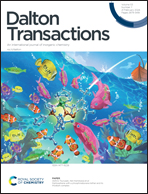Aluminum ion intercalation in mesoporous multilayer carbocatalysts promotes the conversion of glucose to 5-hydroxymethylfurfural†
Abstract
In this study, an efficient modification strategy was proposed by facile loading of trace aluminum ions and p-toluene sulfonic acid (p-TSA) in carbon materials to improve their catalytic activity. p-TSA is then proven to regulate the carbonization process and promote the formation of mesoporous and multilayer structures. The hexa-coordinated aluminum structure is characterized by 1H–27Al solid-state nuclear magnetic resonance (SSNMR) and X-ray photoelectron spectroscopy, which serves as the Lewis–Brønsted acid site in carbocatalysts. Accordingly, the resulting catalyst facilitates a yield of ∼70% for converting glucose to 5-hydroxymethylfurfural (HMF) with a maximum carbon balance of around 91.4% at 150 °C in 6 h. In situ NMR, electrospray ionization mass spectrometry and isotope labeling analysis reveal that the hexa-coordinated aluminum sites promote the isomerization of glucose, and the sulfonic groups facilitate the subsequent dehydration and rehydration of fructose and levoglucosan intermediates. Kinetic models further indicate the decreased energy barrier for glucose conversion over the Al3+/p-TSA intercalated carbocatalyst. This work provides a promising strategy for engineering waste-derived carbocatalysts toward effectively converting carbohydrates to precursors of biofuels and bioplastics.



 Please wait while we load your content...
Please wait while we load your content...